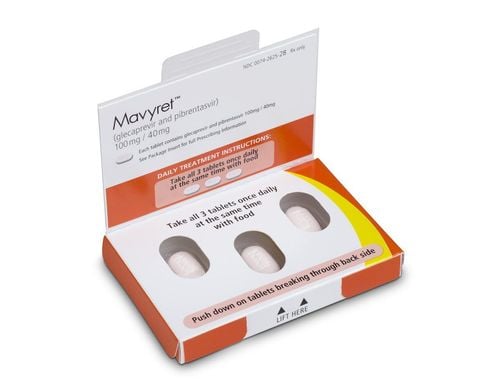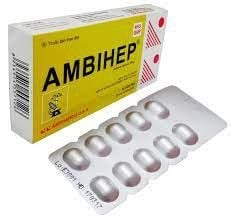This is an automatically translated article.
Caavirel has the main active ingredient is the anti-hepatitis B virus Entecavir 0.5mg. This product is usually indicated in the treatment of chronic hepatitis B or when the HBV virus is resistant to Lamivudin. So what does Caavirel do?
1. What does Caavirel do?
Caavirel has the main ingredient is Entecavir (in the form of Entecavir monohydrate) 0.5mg. Caavirel is manufactured by Pymepharco Joint Stock Company (Vietnam) and circulated with registration number VD-28290-17. Caavirel is prepared in the form of film-coated tablets, packed in each box of 3 blisters x 10 tablets.
Entecavir is a Guanin-derivative Nucleoside Purin analogue with activity against human hepatitis B virus (HBV). After entering the body, Caavirel will be phosphorylated by cellular enzymes to form the active metabolite, Entecavir triphosphate. Through the mechanism of competition with the natural substrate Deoxyguanosin triphosphate, Entecavir triphosphate will inhibit the enzyme DNA polymerase (a reverse transcriptase) of the human hepatitis B virus, thereby blocking all enzyme activity. this.
2. Indications of the drug Caavirel
Caavirel is indicated for the treatment of chronic hepatitis B virus (HBV) infection in adults and children 16 years of age and older with evidence that HBV is actively replicating (elevated DNA-HBV in the blood). , with persistent elevations of liver enzymes (ALT or AST), or histological evidence of active liver disease.
Indications for treatment of Caavirel depend on histological, virological, biochemical and serological responses in cases where no previous nucleoside antiviral drugs have been used, or when HBV virus is resistant to lamivudine, concomitantly with lamivudine. when HBeAg is positive or negative with compensated liver function.
There are limited data on the use of Caavirel in HBV and HIV co-infections.
3. Contraindications of the drug Caavirel
According to the manufacturer's recommendations, the drug Caavirel has so far not had any absolute contraindications. However, patients should not use it if they have the following problems:
History of hypersensitivity to Entecavir or any of the ingredients in Caavirel; Patients who are pregnant or lactating; Children under 16 years of age are not recommended to take Caavirel.
4. How to use, dose of Caavirel
Dosage of Caavirel for adults and children over 16 years old:
Patients with chronic HBV infection who have never been treated with nucleoside analogues: It is recommended to start with 1 tablet of Caavirel 0.5mg x 1 time/day; History of HBV infection during treatment with Lamivudine or evidence that HBV is resistant to Lamivudine or Telbivudine: 2 Caavirel tablets (equivalent to 1mg Entecavir) x 1 time. The optimal duration of treatment with Caavirel has not been precisely determined, but it should be maintained for a minimum of 1 year. Patients may discontinue treatment with Caavirel when the following conditions are met:
HBeAg-positive patients must be treated for at least until HBe seroconversion (HBeAg and HBV-DNA negative with antibody detection) anti-HBe at 2 consecutive blood draws 3-6 months apart) or until HBs seroconversion or no therapeutic effect after 1 year of taking the drug; HBeAg (negative) patients should be treated with Caavirel at least until DNA-HBV levels are negative (below threshold of detection) and HBs seroconversion occurs, or when no therapeutic effect is seen. Patients treated with Caavirel for more than 2 years should be regularly evaluated to determine whether treatment should be continued. Dosage of Caavirel for other subjects:
Elderly: No dose adjustment of Caavirel is required. However, the use of drugs in this subject should be noted that kidney function often declines with age; Patients with renal impairment must adjust the dose of Caavirel according to creatinine clearance. Patients can reduce their dose by switching from Caavirel to Entecavir oral solution or by increasing the interval between doses. How to take Caavirel :
This product is only used as prescribed by a specialist; The best time to take Caavirel is on an empty stomach, at least 2 hours before or after a meal. Caavirel overdose and management:
Entecavir overdose data are currently very limited. Reports have shown that a patient took a dose of 20mg/day for 14 days and took a dose of 40mg without any signs of toxicity; How to handle overdose: Patients who take Caavirel in excess of the recommended dose should be monitored for developments to promptly handle.
5. Side effects of the drug Caavirel
Common unwanted effects of Caavirel :
Hematuria ; Increased creatinine and glucose in urine; Insomnia; Headache; Vomiting, loose stools, indigestion; Increased liver enzymes, amylase or bilirubin in the blood; Tired. Some less common side effects of Caavirel :
Rash; Hair loss; Full stomach. More rarely, patients taking Caavirel may experience the following problems:
Anaphylactic reactions; Lactic acidosis; Increased ALT more than 5 times the upper limit of normal; Lipase elevation of at least 2.1 upper limit of normal; Hyperbilirubinemia more than 2 times the upper limit of normal.
6. Caavirel drug interactions
To date there have been no known drug interactions that are recommended to avoid concomitant use with Caavirel .
Entecavir concentration and effect may be increased when Caavirel is used concurrently with Ganciclovir, Valganciclovir, Ribavirin. Entecavir is not a substrate and does not inhibit or stimulate Cytochrome P450 (CYP) enzymes, so Caavirel is unlikely to interact pharmacokinetics with drugs metabolised by P450. Entecavir affects renal function or is eliminated by the kidneys, so Caavirel has the potential to interact with other drugs that also affect renal function or compete with Entecavir for active tubular secretion. . As serum concentrations of Caavirel or concentrations of the combination drug may increase, monitoring for possible adverse events is required. Entecavir does not occur with other antiviral drugs such as Adefovir, Lamivudine, Tenofovir or Disoproxil. Immunosuppressive agents with the potential to interact with Caavirel in terms of pharmacokinetics (increasing serum concentrations of Entecavir due to altered renal function), include Cyclosporin or Tacrolimus. Renal function should be monitored before and during treatment with Caavirel in liver transplant patients receiving cyclosporin, tacrolimus or other immunosuppressive agents that may affect renal function.
7. Notes when using the drug Caavirel
Patients treated with Caavirel may develop spontaneous (sometimes severe) hepatitis, usually manifested by transient elevations in serum ALT levels. After a period of antiretroviral therapy, serum ALT levels may also increase while serum HBV-DNA levels decrease. During treatment with Caavirel, patients must be closely monitored both for clinical symptoms and for blood biochemical tests. Several cases of worsening of the disease have been reported upon discontinuation of hepatitis B treatment with Entecavir. Patients who stop taking Caavirel often have elevated serum HBV-DNA levels and most resolve spontaneously, but in rare cases, death. Among previous nucleoside-nave patients who were treated with Caavirel, exacerbations were observed on average 23 to 24 weeks after discontinuation of treatment, most of which were tested for HBeAg. negative. Patients should be monitored for liver function periodically (clinical and biochemical) for at least 6 months after stopping treatment. Cases of increasing DNA-HBV may be indicated for another course of treatment. Caavirel should be used with caution in patients with decompensated cirrhosis, because of the higher risk of adverse events, especially lactic acidosis. Care should be taken when administering Caavirel to chronic HBV infection without HIV co-infection, because of the increased risk of developing resistant strains of HIV Nucleoside reverse transcriptase inhibitor (NRTI). Before initiating Caavirel therapy, patients should be tested for HIV and should not use Caavirel for the treatment of chronic HBV infection co-infected with HIV. Caution is advised when appointing Caavirel for the treatment of chronic hepatitis B in patients receiving Nucleoside analogues alone or in combination with other antiviral agents because of the increased risk of lactic acidosis, hepatomegaly with steatosis . This problem occurs most often in women, in obese patients, and in long-term treatment with nucleoside reverse transcriptase inhibitors. Caution should be exercised when prescribing nucleoside analogues (including Caavirel) to individuals at high risk for liver disease, but lactic acidosis, hepatomegaly, and fatty liver have also occurred in non-alcoholics. have any risk factors. Discontinue Caavirel immediately if the patient has any clinical signs and laboratory findings suggestive of lactic acidosis or severe hepatotoxicity even if liver transaminases are not elevated. The safety and efficacy of Caavirel in humans after liver transplantation have not been established. If Caavirel must be administered to a liver transplant recipient who has or is taking an immunosuppressive drug that may affect renal function such as Cyclosporin, Tacrolimus, the physician must plan to carefully monitor renal function before and during treatment. . In persons 65 years of age and older, experience with Caavirel is limited, so it is not sufficient to determine whether response is different from younger patients. Since Entecavir is primarily eliminated by the kidneys, the risk of toxicity may be increased in patients with renal impairment. Elderly people often have impaired renal function, so the dose of Caavirel should be adjusted according to the degree of renal impairment and renal function should be monitored periodically. Dosage adjustment of Caavirel is recommended when creatinine clearance is less than 50 ml/min, including cases of hemodialysis or outpatient peritoneal dialysis. Entecavir does not reduce the risk of transmitting the virus to others, so patients taking Caavirel should still take other HBV infection prevention measures. There are no studies on the use of Caavirel in pregnancy and there are no data on the effect of Entecavir on mother-to-child transmission of HBV. Infants born to HBV-infected mothers are generally recommended to receive a combination regimen of HBV vaccine with Hepatitis B Immune Globulin (HBIG). It is not known whether Entecavir is excreted in human milk, however patients should discontinue nursing or not use Caavirel depending on the importance of the drug to the mother. There are no studies on the effects of Caavirel on the ability to drive and use machines. Some side effects such as dizziness, fatigue and somnolence due to Caavirel may reduce cognitive ability, so caution should be exercised when patients drive and use complex machinery. Caavirel medicine has the main active ingredient of the anti-hepatitis B virus Entecavir 0.5mg. This product is usually indicated in the treatment of chronic hepatitis B or when the HBV virus is resistant to Lamivudin. To ensure the effectiveness of treatment and avoid unwanted side effects, patients need to strictly follow the instructions of the doctor, professional pharmacist.
Follow Vinmec International General Hospital website to get more health, nutrition and beauty information to protect the health of yourself and your loved ones in your family.













